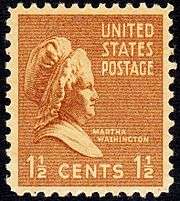Martha Washington
| Martha Washington | |
|---|---|
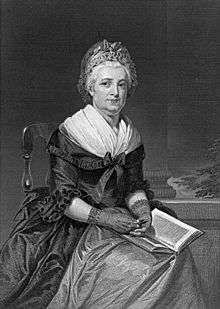 | |
| First Lady of the United States | |
|
In role April 30, 1789 – March 4, 1797 | |
| President | George Washington |
| Preceded by | Position established |
| Succeeded by | Abigail Adams |
| Personal details | |
| Born |
Martha Dandridge June 2, 1731 Chestnut Grove, Virginia, British America |
| Died |
May 22, 1802 (aged 70) Mount Vernon, Virginia, U.S. |
| Spouse(s) |
Daniel Custis (1750–1757) George Washington (1759–1799) |
| Children |
Daniel Frances Jacky Patsy |
| Parents |
John Dandridge Frances Jones |
| Religion | Church of England |
| Signature |
|
Martha Washington (née Dandridge; June 13 [O.S. June 2] 1731– May 22, 1802) was the wife of George Washington, the first president of the United States. Although the title was not coined until after her death, Martha Washington is considered to be the first First Lady of the United States. During her lifetime she was often referred to as "Lady Washington".[1]
Widowed at 25, she had four children with her first husband Daniel Parke Custis. Two of her children by Custis survived to young adulthood. She brought great wealth to her marriage to Washington, which enabled him to buy land and many slaves to add to his personal estate. She also brought nearly 100 dower slaves for her use during her lifetime; they and their descendants reverted to her first husband's estate at her death and were inherited by his heirs.[2] She and Washington did not have children together but they did rear her two children by Daniel Parke Custis, including son John "Jacky" Parke Custis, as well as helped both of their extended families.
Family and background
Martha Dandridge was born on June 2, 1731[3] on her parents' plantation Chestnut Grove in the British colony, Province of Virginia. She was the oldest daughter of John Dandridge (1700–1756), a Virginia planter and immigrant from England, by his wife Frances Jones (1710–1785), who was of American birth and English, Welsh, and French descent.[4] Martha had three brothers and four sisters: John (1733–1749), William (1734–1776), Bartholomew (1737–1785), Anna Marie "Fanny" Bassett (1739–1777), Frances Dandridge (1744–1757), Elizabeth Aylet Henley (1749–1800) and Mary Dandridge (1756–1763).
.jpg)
Martha may have had an illegitimate half-sister, Ann Dandridge Costin (years of birth and death unknown) who was born into slavery;[5] Costin's enslaved mother was of African and Cherokee descent, and her father was believed to be John Dandridge.[6] Martha's father may also have fathered an out-of-wedlock half-brother to Martha named Ralph Dandridge (years of birth and death unknown), who was probably white.[6]
First marriage
On May 15, 1750, at age 18, Martha married Daniel Parke Custis, a rich planter two decades her senior, and moved to his residence, White House Plantation, located on the south shore of the Pamunkey River, a few miles upriver from Chestnut Grove. They had four children together: Daniel, Frances, John, and Martha. Daniel (1751–1754) and Frances (1753–1757) died in childhood. The other two children, John (Jacky) Parke Custis (1754–1781) and Martha ("Patsy") Parke Custis (1756–1773), survived to young adulthood. Her husband's death in 1757 left Martha a rich young widow at age 25, with independent control over a dower inheritance for her lifetime, and trustee control over the inheritance of her minor children. In all, she was left in custody of some 17,500 acres of land and 300 slaves, apart from other investments and cash.[7] According to her biographist, "she capably ran the five plantations left to her when her first husband died, bargaining with London merchants for the best tobacco prices."[8]
Second marriage
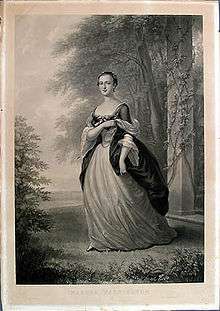
Martha Dandridge Custis, age 27, and George Washington, age nearly 27, married on January 6, 1759, at the White House plantation. As a man who lived and owned property in the area, Washington likely knew both Martha and Daniel Parke Custis for some time before Daniel's death. During March 1758 he visited her twice at White House; the second time he came away with either an engagement of marriage or at least her promise to think about his proposal. At the time, she was also being courted by the planter Charles Carter, who was even wealthier than Washington.[8]
The wedding was grand. Washington's suit was of blue and silver cloth with red trimming and gold knee buckles.[9] The bride wore purple silk shoes with spangled buckles, which are occasionally displayed at Mount Vernon.[8] The couple honeymooned at White House for several weeks before setting up house at Washington's Mount Vernon estate. They appeared to have had a solid marriage.[8][9] Martha and George Washington had no children together, but they raised Martha's two surviving children. Her daughter, nicknamed Patsy, died as a teenager during an epileptic seizure, classed as SUDEP. John Parke "Jacky" Custis returned from college to comfort his mother.
Custis later married and had children; he served as an aide to Washington during the siege of Yorktown in 1781 during the American Revolutionary War. He died of "camp fever" (probably epidemic typhus). After his death, the Washingtons raised two of John's four children, Eleanor (Nelly) Parke Custis (March 31, 1779 - July 15, 1852), and George Washington Parke Custis (April 30, 1781 - October 10, 1857). They also provided personal and financial support to nieces, nephews and other family members in both the Dandridge and Washington families.
Content to live a private life at Mount Vernon and her homes from the Custis estate, Martha Washington followed Washington to his winter encampments for each of eight years. She helped keep up morale among the officers.
First Lady 1789-1797
After the war, she opposed George Washington's agreeing to be President of the newly formed United States of America, and she did not attend his inauguration on April 30, 1789. Once he assumed office, as the First Lady Martha Washington hosted many affairs of state at New York City and Philadelphia during their years as temporary capitals. The socializing became known as "the Republican Court".[10][11](subscription required)
Martha Washington at the 1777–78 Valley Forge encampment
Washington has traditionally been seen as spending her days at the Revolutionary War winter encampments visiting with the common soldiers in their huts. But Nancy Loane, author of Following the Drum: Women at the Valley Forge Encampment, says there is no evidence that Washington visited with the common soldiers,[12] noting that Martha Washington was fashionably dressed, assertive, and a woman of great wealth and independent means. Mrs. Washington joined her husband during the Revolution for all the Continental Army's winter encampments. Before the revolution began, she had kept close to home; during it, she traveled thousands of miles to be with her husband.[13] General Lafayette observed that she loved "her husband madly".[14]
The Continental Army settled in Valley Forge, the third of the eight winter encampments of the Revolution, on December 19, 1777. Martha Washington traveled ten days and hundreds of miles to join her husband in Pennsylvania.[15] Primary documents of the Revolutionary period refer to Lady Washington's activities at the site.
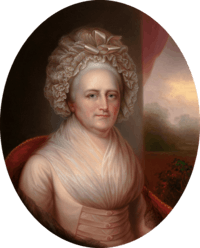
Martha Washington took her familiar role as her husband's hostess at camp. On April 6, Elizabeth Drinker and three friends arrived at Valley Forge to plead with General Washington to release their husbands from jail; the men, all Quakers, had refused to swear a loyalty oath to the United States. Because the commander was not available at first, the women visited with Mrs. Washington. Martha Washington was regarded as a matriarch in the camps she visited.[16] Drinker described her later in her diary as “a sociable pretty kind of Woman.”[17] Although unable to satisfy the womens' demands, General Washington invited them to dine at headquarters that day. Drinker said the dinner with General and Mrs. Washington and fifteen officers was “elegant” but “soon over.”[17]
Martha Washington also socialized with the wives of the senior officers at Valley Forge. Years later, Pierre DuPonceau, an aide to Baron von Steuben, recalled that in the evenings the ladies and officers at camp would meet at each other’s quarters for conversation. During these social evenings each lady and gentleman present was “called upon in turn for a song” as they sipped tea or coffee,[18] but there was no card-playing during these Valley Forge social gatherings, games of chance having been forbidden by General Washington.[19]
Charles Willson Peale painted a miniature of Washington—for which he charged his usual “56 Dollars”—and presented it to Martha, along with painting other miniatures of Washington.[20] He also painted 50 other officers and their wives that winter.[21]
Lady Washington took part in the camp’s May 6 celebration of the formal announcement of the French-American alliance.[22] Soon after the thunderous feu de joie, when thousands of soldiers fired off their muskets, General Washington and his wife received other officers under a large marquee fashioned from dozens of officers’ tents. General Washington was said to have worn “a countenance of uncommon delight and complacence.”[23]
Five days later, on May 11, Martha Washington and the commander attended the camp production of Joseph Addison's play Cato, a favorite of the General’s. The play was performed by the staff officers for a “very numerous and splendid audience,” including many officers and several of their wives.[24] One officer wrote that he found the performance “admirable” and the scenery “in Taste.”[24]
Dower slaves, estate, death and interment
Although her father owned only fifteen to twenty slaves, her first husband, Daniel Parke Custis, owned nearly three hundred, making him one of the wealthiest men in the Virginia colony.[25] The full Custis estate contained plantations and farms totaling about 27 square miles (70 km2), and 285 enslaved men, women, and children attached to those holdings.
Daniel Parke Custis’ death in 1757 without a will meant that, according to law, his and Martha’s eldest male child, John (Jacky) Parke Custis, who was at that time a minor, would inherit when he became an adult two-thirds of the Custis estate, its slaves and the children of those slaves.[25] Martha received a "dower share," the lifetime use of (and income from) the remaining one-third of the estate and its slaves.[25] After her death, the dower slaves and their progeny were to be distributed among the surviving Custis heirs.[25]
Upon his 1759 marriage to Martha, George Washington became the legal manager of the Custis estate, under court oversight. At the time of her marriage, Martha's dower share included more than 80 slaves;[26] she also would control any children they had, as they would become part of the dower.[25] Estate records indicate that Martha Washington continued to purchase supplies, manage paid staff, and make many other decisions. Although the Washingtons wielded managerial control over the whole estate, they received income only from Martha's "dower" third. The remainder of the income went to a trust held for Jacky Custis until Jacky reached maturity.
Washington used his wife's great wealth to buy land and slaves; he more than tripled the size of Mount Vernon (2,650 acres (10.7 km2) in 1757; 8,251 acres (33.39 km2) in 1787). For more than 40 years, her "dower" slaves farmed the plantation alongside her husband's. By law, neither of the Washingtons could sell Custis lands or slaves, which Martha's dower and the trust owned.[25][26] After Jacky died during the Revolutionary War, his slaves passed to his son, George Washington Parke Custis, who at the time was a minor. If Jacky's trust or Martha's dower owned a slave's mother, they also held the mother's children. Some slaves owned by the Washingtons and the trust married each other, forming linked families.[27]
Seven of the nine slaves whom President Washington brought to Philadelphia (the national capital, 1790–1800) to work in the President's House were "dowers." Pennsylvania passed a gradual abolition law in 1780, under which non-residents were allowed to hold slaves in the state for up to 6 months; after that date, they could claim freedom. The Washingtons rotated their President's House slaves in and out of the state before the 6-month deadline to prevent their establishing residency (and legally qualifying for manumission).[2] Washington reasoned that should the "dowers" attain their freedom due to his negligence, he might be liable to the Custis estate for their value.
Martha Washington was upset when her lady's maid Oney Judge, a "dower" slave, escaped in 1796 from the Philadelphia household during Washington's second term.[25] According to interviews with Judge in the 1840s, the First Lady had promised the young woman as a wedding gift to her granddaughter Elizabeth Parke Custis in Virginia and Judge feared she would never gain freedom.[28] She hid with free black friends in the city, who helped arrange her travel by ship to Portsmouth, New Hampshire. There she married and had three children. Patricia Brady, in her 2005 biography of Martha Washington, writes:
- "Martha felt a responsibility for the unsophisticated girl under her care, especially since her mother and sister were expecting to see her back at Mount Vernon. What she could never understand was that [Oney had...] a simple desire to be free. Ona, as she preferred to call herself, wanted to live where she pleased, do what work she pleased, and learn to read and write [...] Ona Judge professed a great regard for Martha and the way she had been treated, but she couldn't face a future as a slave for herself and her children."[29]
Washington's slave Hercules, who had worked as his chief cook at the President's House (Philadelphia) before being returned to Mount Vernon in 1796, escaped from there on February 22, 1797.[30] He was known to have traveled to Philadelphia and by December 1801 was living in New York City.[31][32] His six-year-old daughter, still enslaved at Mount Vernon, told a visitor that she was glad her father was free.[33]
In his July 1790 will, written a year after he became President of the United States in April 1789 and nine years before his death in December 1799, George Washington left directions for the emancipation, after Martha Washington's death, of all the slaves that he owned.[27] Of the 318 slaves at Mount Vernon in 1799, a little less than half, 123 individuals, belonged to George Washington.[26] His will stipulated that his slaves were not to be freed until Martha's death because of his desire to preserve the families of those who had intermarried with Martha's dower slaves.[27]
In accordance with state law, George Washington stipulated in his will that elderly slaves or those who were too sick to work were to be supported throughout their lives by his estate. Children without parents, or those whose families were too poor or indifferent to see to their education, were to be bound out to masters and mistresses who would teach them reading, writing, and a useful trade, until they were ultimately freed at the age of twenty-five.[26]
In December 1800, Martha Washington signed a deed of manumission for her deceased husband's slaves, a transaction that was entered into the records of Fairfax County, Virginia, but lost during the American Civil War.[34] The slaves received their freedom on January 1, 1801, a little over a year after George's death.[26][35]
Just a few weeks earlier in December, Abigail Adams, wife of the second President, had visited Mount Vernon and wrote: "Many of those who are liberated have married with what are called the dower Negroes, so that they all quit their [family] connections, yet what could she do?" Mrs. Adams suggested a motive for Martha to have freed Washington's slaves early:
"In the state in which they were left by the General, to be free at her death, she did not feel as tho her Life was safe in their Hands, many of whom would be told that it was [in] their interest to get rid of her–She therefore was advised to set them all free at the close of the year.–" (A. A. to Mary Cranch, 21 December 1800)[36]
Martha’s health, always somewhat precarious, declined after George Washington's death.[37] Two and a half years after the death of her husband, Martha died on May 22, 1802 at the age of 70.[37]
Following her death, Martha was interred in George Washington's tomb vault at Mount Vernon.[38] In 1831, the surviving executors of Washington's estate removed the bodies of George and Martha Washington and those of other members of the family from the old vault to a similar structure within the present enclosure at Mount Vernon.[38]
Martha did not emancipate any of her own slaves during her lifetime.[25] Her will bequeathed Elisha, a slave that she owned outright at the time of her death, to her grandson, George Washington Parke Custis.[39] Upon her death, her dower slaves reverted to the Custis estate and were divided among her four grandchildren.[2][25][26] The division split up families, divided husbands from wives and sent children away from their parents.[25]
| Martha Washington | ||||||||
|---|---|---|---|---|---|---|---|---|
|
Honors
USS Lady Washington
Mrs. Washington had a row galley named in her honor, the USS Lady Washington. It holds the distinction of being the first U.S. military ship to be named in honor of a woman and the first named for a person while the person was still alive (see also List of U.S. military vessels named after living Americans). It has a number of other distinctions as well, such as the first ship named after a (future) First Lady and one of the few active vessels in the U.S. Navy named in honor of a woman (see also USS Hopper).
USS Martha Washington
The USS Martha Washington (ID-3019) was a transport for the United States Navy during World War I. She was originally the ocean liner SS Martha Washington for the Austro-American Line before the war. Before and after her Navy service she was the United States Army transport USAT Martha Washington. The liner was sold to the Italian Cosulich Line in 1922. In 1932, when Cosulich was absorbed into Italia Flotte Riunite (English: United Fleets Italy), the ship was renamed SS Tel Aviv. The ship was scrapped in 1934.
Martha Washington on U.S. postage
The first US stamp honoring an American woman honored Martha Washington, and was issued in 1902.[40][41] This 8c issue was printed in black with Martha's portrait surrounded by an elaborate laurel wreath. In 1923, a second stamp was issued in her honor, a 4-cent definitive stamp. The third issue to honor Martha Washington was issued in 1938, a 1½¢ denomination stamp.
| Martha Washington on U.S. postage | ||||
|---|---|---|---|---|
|
U.S. paper currency
Martha Washington is the only woman (other than allegories of Justice, Liberty, etc.) depicted on the face of a United States Banknote. Her engraved portrait bust was used on the face of the $1 Silver Certificate of 1886 and 1891. Both Martha and George Washington are depicted together on the reverse of the $1 silver certificate of 1896.
- Martha Washington on U.S. paper currency
 $1 silver certificate, issue 1886
$1 silver certificate, issue 1886.jpg) $1 Silver Certificate, issue 1896
$1 Silver Certificate, issue 1896
U.S. coins
The First Spouse Program under the Presidential $1 Coin Act authorizes the United States Mint to issue 1/2 ounce $10 gold coins and bronze medal duplicates[42] to honor the first spouses of the United States.The Martha Washington coin was released on June 19, 2007, and was sold out in hours.
- Martha Washington on U.S. coin currency
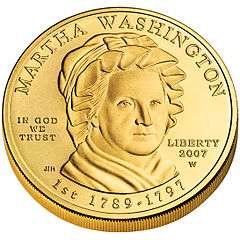 Obverse
Obverse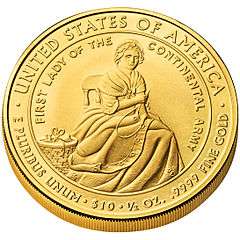 Reverse
Reverse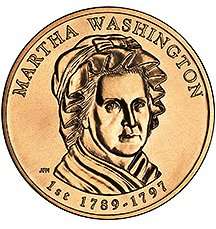 Obverse (bronze medal)
Obverse (bronze medal)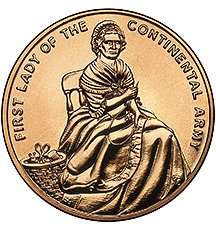 Reverse (bronze medal)
Reverse (bronze medal)
Educational institutions
 | |
|
|
The Martha Washington College for Women was founded in Abingdon, Virginia in 1860.[44] In 1918, its administration was merged with Emory & Henry College[45] and in 1931, Martha Washington ceased to function as a separate entity, merging completely with Emory & Henry. The main original building of Martha Washington College is now known and operated as the Martha Washington Inn.[46] There was also Martha Washington Seminary, a finishing school for young women in Washington, DC,[47] that was founded in 1905[48] and ceased operations in 1949.[49]
In popular culture
- In 1955, the actress Karen Sharpe played Custis in the NBC television film, The Courtship of George Washington and Martha Custis, a production of the Hallmark Hall of Fame. Marshall Thompson, nine years older than Sharpe, portrayed Washington, who was a year younger than Custis.[50]
- Annette Haven played Martha Washington in the 1976 pornographic film Spirit of Seventy Sex.
- Emmy-winning actress Patty Duke portrayed Martha Washington in the TV miniseries George Washington (1984) and its sequel George Washington II: The Forging of a Nation (1986).
- Martha Washington is the name of a fox in The Life and Times of Grizzly Adams, episode 2 ("Blood Brothers").
- A member of the geranium (a flower) family, scientific name being Pelargonium x domesticum, is named after Martha Washington as the Martha Washington geranium.[51]
See also
- Alexander Macomb House (New York City) — Second Presidential Mansion.
- List of slave owners
- President's House (Philadelphia, Pennsylvania) — Third Presidential Mansion.
- Samuel Osgood House (New York City) — First Presidential Mansion.
References
- ↑ Figueroa, Acton (1 January 2003). Washington,. World Almanac Library. p. 10. ISBN 978-0-8368-5162-5.
- 1 2 3 Dunbar, Erica Armstrong (February 16, 2015). "George Washington, Slave Catcher". New York Times. Retrieved February 16, 2015.
- ↑ "Martha Washington - Early Life: Birth and Family of Origin". MarthaWashington.US(Center for History and New Media/The Mount Vernon Ladies' Association). Retrieved June 2, 2012.
- ↑ "Martha Washington Biography :: National First Ladies' Library".
- ↑ Wiencek, Henry (2013). An Imperfect God: George Washington, His Slaves, and the Creation of America. Macmillian. p. 286. Retrieved May 23, 2016.
- 1 2 Bryan, Helen (2002). Martha Washington, First Lady of Liberty. Wiley. pp. 26–27. ISBN 978-0-471-15892-9. Retrieved May 23, 2016.
- ↑ "Martha Dandridge Custis Washington." Gale Biography in Context. Detroit: Gale, 2002. Biography in Context. Web. 15 Oct. 2015.
- 1 2 3 4 Brigid Schulte, "Fresh Look at Martha Washington: Less First Frump, More Foxy Lady", Washington Post, 1 February 2009, accessed 1 April 2012
- 1 2 The Complete Book of U. S. Presidents ISBN 0-517-18353-6
- ↑ Griswold, Rufus W. (1854). The Republican court : or, American society in the days of Washington. B. Appleton & Co. p. 163.
and from this time the drawing-rooms of the presidential residence were opened from eight till ten o'clock every Friday evening for visits to Mrs. Washington
- ↑ David S. Shields and Fredrika J. Teute. "The Republican Court and the Historiography of a Women's Domain in the Public Sphere." Journal of the Early Republic 35#2 (2015): 169-183. online summary abstract(subscription required)
- ↑ Loane, Nancy K. Following the Drum: Women at the Valley Forge Encampment. Potomac Books, Inc., Washington, D.C., 2009. ISBN 978-1-59797-385-4.
- ↑ Thompson, Mary. "Martha Washington". www.mountvernon.org. Mount Vernon Ladies' Association. Retrieved February 17, 2015.
- ↑ Lafayette to Adrienne de Noailles de Lafayette, January 6, 1778, in Lafayette in the Age of the American Revolution, ed. Stanley J. Idzerda (Ithaca: Cornell University Press, 1977), 1: 225.
- ↑ Nathanael Greene to Gen. Alexander McDougall, February 5, 1778, in The Papers of General Nathanael Greene, ed. Richard K. Showman (Chapel Hill: University of North Carolina Press, 1980), 2:276.
- ↑ "Martha Washington." Encyclopedia of World Biography. Vol. 32. Detroit: Gale, 2012. Biography in Context. Web. 15 Oct. 2015.
- 1 2 Elizabeth Sandwith Drinker, The Diary of Elizabeth Drinker, ed. Elaine Foreman Crane (Boston: Northeastern University press, 1991), page 297
- ↑ "Autobiographical Letters of Peter S. DuPonceau," The Pennsylvania Magazine of History and Biography XL (1916): 181.
- ↑ Trevelyan, Sir George Otto (1922). The American Revolution, Volume 4. Longmans, Green. p. 337. Retrieved February 17, 2015.
- ↑ Charles Willson Peale, The Selected Papers of Charles Willson Peale and His Family, ed. Lillian B. Miller (New Haven, CT: Yale University Press, 1983), 1: 266.
- ↑ John Laurens to Henry Laurens, March 9, 1778, in The Army Correspondence of Colonel John Laurens in the Years 1777-1778 (New York: The New York Times and the Arno Press, 1969), 139.
- ↑ Mark E. Lender and James Kirby Martin, Citizen Soldier: The Revolutionary War Journal of Joseph Bloomfield(Newark: New Jersey Historical Society, 1982), 134.
- ↑ John F. Reed, Valley Forge: Crucible of Victory (Monmouth Beach: Peter Freneau Press, 1969), 56.
- 1 2 William Bradford, Jr. to Rachel Bradford, May 14, 1778, in Joseph Lee Boyle, Writings from the Valley Forge Encampment (Bowie, MD: Heritage Books, 2001), 2:125.
- 1 2 3 4 5 6 7 8 9 10 "Martha Washington & Slavery". George Washington's Mount Vernon: Digital Encyclopedia. Mount Vernon Ladies' Association. 2015. Archived from the original on 2015-09-05. Retrieved 2015-12-04.
- 1 2 3 4 5 6 "George Washington and Slavery". George Washington's Mount Vernon: Digital Encyclopedia. Mount Vernon Ladies' Association. 2015. Archived from the original on 2015-09-05. Retrieved 2015-11-30.
- 1 2 3 (1) Washington, George (1790-07-09). "Last Will and Testament". Rediscovering George Washington. PBS. Archived from the original on 2005-02-06. Retrieved 2015-12-04.
Upon the decease of my wife, it is my Will and desire, that all the slaves which I hold in my own right, shall receive their freedom. To emancipate them during her life, would, tho' earnestly wished by me, be attended with such insuperable difficulties on account of their intermixture by Marriages with the Dower Negroes, as to excite the most painful sensations, if not disagreeable consequences from the latter, while both descriptions are in the occupancy or the same Proprietor; it not being in my power, under the tenure by which the Dower Negroes are held, to manumit them.
(2) Pogue, Dennis J. (2006-06-12). "George Washington: His Troubles with Slavery". HistoryNet.comaccessdate=2015-12-04. Archived from the original on 2015-09-16. - ↑ Two 1840s interviews with Oney Judge
- ↑ Brady, Patricia (2005). Martha Washington: An American Life. New York, New York: Viking/Penguin Group. p. 209. ISBN 0-670-03430-4.
- ↑ "A birthday shock from Washington's chef", Philadelphia Inquirer, 22 February 2010
- ↑ Frederick Kitt to George Washington, 15 January 1798. The Papers of George Washington, Retirement Series, vol. 2, p. 25.
- ↑ Martha Washington to Col. Richard Varick, 15 December 1801. "Worthy Partner:" The Papers of Martha Washington, Joseph E. Fields, ed., (Westport, CT: Greenwood Press, 1994), pp. 398-99.
- ↑ Louis-Philippe, Diary of My Travels in America, translation by Stephen Becker (New York: Delacorte Press, 1977), p. 32.
- ↑ Notes of the Publisher: Dower Negroes. Authenticated Copy of the Last Will and Testament of George Washington of Mount Vernon, Embracing a Sechedule of his Real Estate and Notes Thereto by the Testator. To Which is Added Historical Notes and Biographical Sketches, by the Publisher. Washington, D.C.: A.J. Jackson. 1868. p. 9. At Google Books.
- ↑ Chadwick, Bruce (2007). General and Mrs. Washington: The Untold Story of a Marriage and a Revolution. Sourcebooks, Inc. p. 331. Retrieved February 17, 2015.
- ↑ Hirschfeld, Fritz (1997). George Washington and Slavery: A Documentary Portrayal. University of Missouri Press. p. 214. Retrieved February 17, 2015.
- 1 2 "The Twilight Years: The Deaths of George and Martha Washington". Martha's biography. Martha Washington - A Life. Archived from the original on 2015-09-08. Retrieved 2015-10-04.
- 1 2 "The Tomb". George Washington's Mount Vernon: Digital Encyclopedia. Mount Vernon Ladies' Association. 2015. Archived from the original on 2015-11-17. Retrieved 2015-12-02.
- ↑ (1) Washington, Martha (1803-03-04). "The will of Martha Washington of Mount Vernon" (PDF). Fairfax County government. Archived from the original (pdf) on 2012-10-16. Retrieved 2015-12-04.
I give to my grandson George Washington Parke Custis my mulato man Elish – that I bought of Mr Butler Washington to him and his heir for ever –
(2) "Transcript of Martha Washington's will" (PDF). Fairfax County government. Archived from the original (pdf) on 2012-10-16. Retrieved 2015-12-04.I give to my grandson George Washington Parke Custis my mulato man Elish – that I bought of Mr Butler Washington to him and his heir for ever –
- ↑ "Martha Washington".
- ↑ "Women Who Left Their Stamp On U.S. Philatelic History". Mode.
- ↑ U.S. Mint: First Spouse Program. Accessed 2008-06-27. "The United States Mint also produces and make available to the public bronze medal duplicates of the First Spouse Gold Coins."
- ↑ "First Lady Martha Washington". C‑SPAN. February 25, 2013. Retrieved November 2, 2014.
- ↑ Tennis, Joe (2004). Southwest Virginia Crossroads: An Almanac of Place Names and Places to See. The Overmountain Press. p. 76. Retrieved July 31, 2012.
- ↑ "A Brief History of Emory & Henry College". Emory & Henry College. Retrieved July 31, 2012.
- ↑ "Martha Washington College". Waymarking.Com. Retrieved July 31, 2012.
- ↑ "Martha Washington Seminary". The Independent. Jul 6, 1914. Retrieved July 28, 2012.
- ↑ Washington, City and Capital. United States Government Printing Office. 1937. p. 673.
- ↑ Cherkasky, Mara (2007). Mount Pleasant. Arcadia Publishing. p. 62. Retrieved July 31, 2012.
- ↑ "The Courtship of George Washington and Martha Custis". Internet Movie Data Base. Retrieved November 26, 2012.
- ↑ "Martha Washington Geranium". © 2015 Scripps Networks, LLC. All rights reserved. Retrieved August 29, 2015.
Further reading
- Fraser, Flora (2015). The Washingtons: George and Martha. "Join’d by Friendship, Crown’d by Love". New York: Alfred A. Knopf. ISBN 978-0-307-27278-2.
External links
| Wikimedia Commons has media related to Martha Washington. |
| Wikisource has original works written by or about: Martha Washington |
| Wikiquote has quotations related to: Martha Washington |
- Martha Washington letters (primary sources)
- Martha Washington at the White House (biography)
- Martha Washington at the National First Ladies Library (biography)
- Martha Washington (George Washington's Mount Vernon)
- Donald Greyfield (Jan 1, 2001). "Martha Dandridge Washington". First of America's First Ladies. Find a Grave. Retrieved Aug 18, 2011. (memorial photos)
- Martha Washington at C-SPAN's First Ladies: Influence & Image
| Honorary titles | ||
|---|---|---|
| New title | First Lady of the United States 1789–1797 |
Succeeded by Abigail Adams |
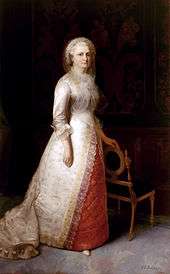


_-_Daniel_Huntington_-_overall.jpg)

